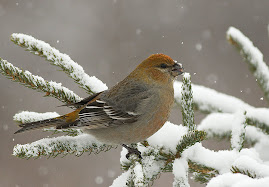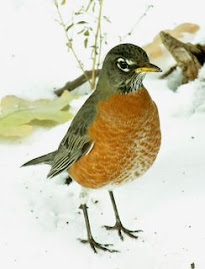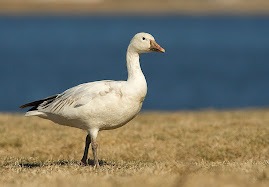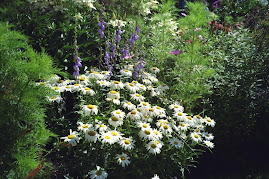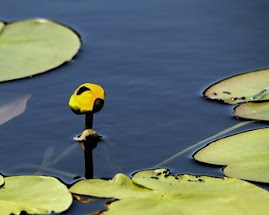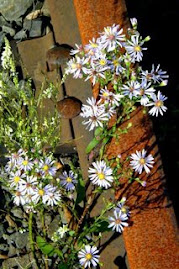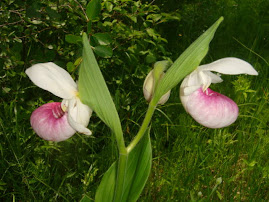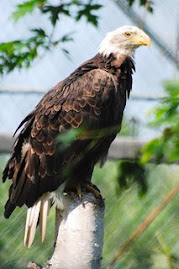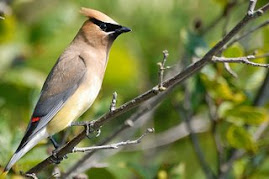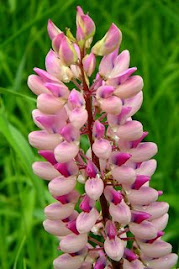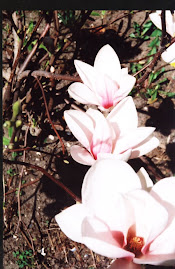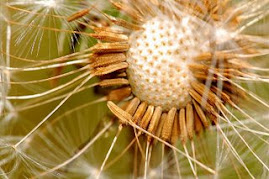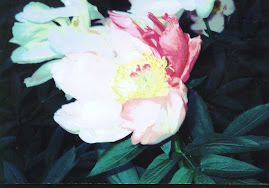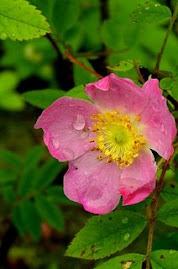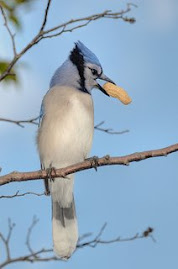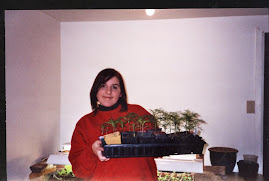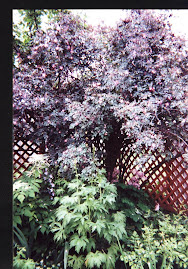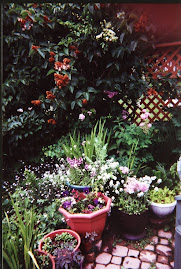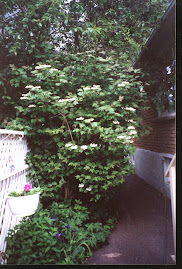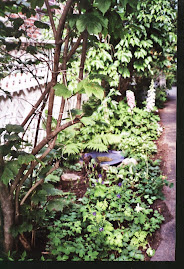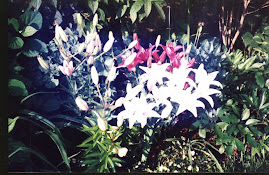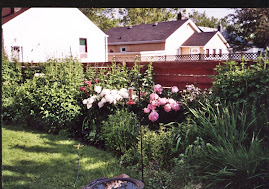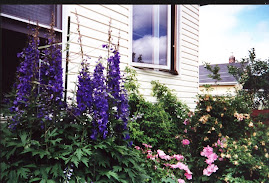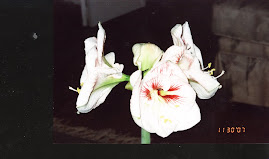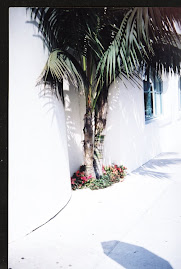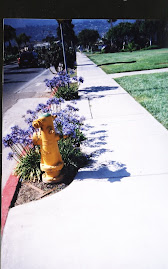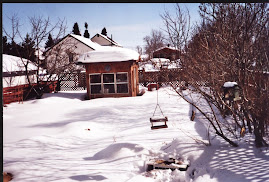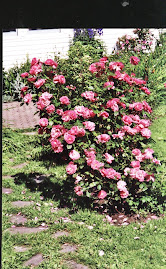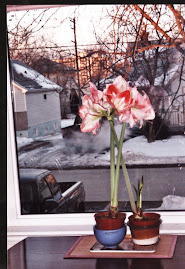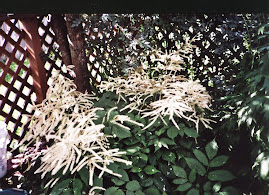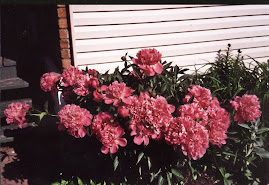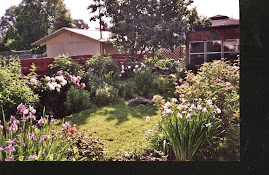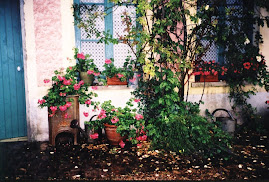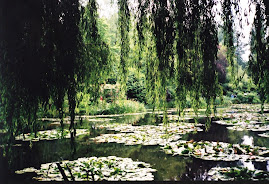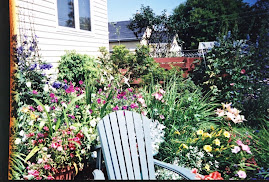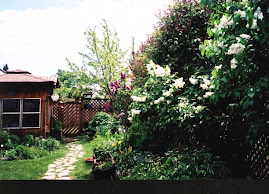Even in this cold weather, the birds are patrolling my garden. I see the house sparrows moving thought the beds and the starlings checking out the lawn. They are eating seeds, thousands of seeds. They are the most efficient weed prevention machines known. A cranky nay-sayer may remark that the seeds are shat out the nether end of said birds but not all seeds. The seeds are food and so are digested, or most of them anyway.
I use birds as the first line of defense against insect pests and excess weeds. They don’t get everything but they get a lot. This means I keep spraying and weeding to a minimum. Here are five ways to attract birds.
1. Birds like thickly planted gardens, the English country garden style. I learned this on a bird watching trip to the village of Grande Isle in Louisiana, a town famous for its birds. As we walked around the tiny houses, birds were everywhere and I noted that few of the citizens did much in the way of gardening or landscaping. Bushes and trees grew thickly around each cottage. However, away from the village, in an up-scale suburb, where gardeners were manicuring the lawns and garden beds, no birds were to be seen. The moral is plain – birds like tangle, lots of different plants.
2. Birds need water. This is even more important than feeders. They like shallow water only a few inches deep. Mostly they like a bird bath on the ground. I have five bird baths. The blue ceramic bath on a stand is an attractive feature of the garden but it is the least popular with the birds. The plain old plant saucers filled with water are used all the time. I even use a scavenged snow saucer as a bird bath – perrrfect! If the bath is too deep, put a brick or stone in for the birds to stand on.
3. Keep the cat inside. Tell your neighbours to keep their cat inside. It is estimated each outdoor cat kills thirty-five birds per summer. It is illegal for cats to run at large in Thunder Bay. Mention this fact often in the neighbourhood. Take feral cats to the Pound. Cats not only chase away birds, they crap in the garden and dig up plants.
4. Birds like insects, seeds and berries. They like native plants but in my garden they are not fussy. The gobble all the seeds from my lilacs over the winter. They feast on the seeds of the delphiniums. They hide out in the cedar trees. They strip all the berries from the Mountain Ash, the high bush cranberry and the nanny berry. They wait until the crab apples are frozen into pulp and then eat them. The moral is to leave the seeds on the plants. I have seen birds chow down on the honeysuckle berries and pick off the aphids at the same time. Most bird species have their favourite food, but many are omnivores who will take anything. I have seen humming birds catching mosquitoes. I have noted chipping sparrows hanging around the outdoor light taking moths. (note – moths lay eggs which become caterpillars which eat my shrubs – so “Go Chippers!”)
5. A bird is a bird is a bird. Some people like robins and chickadees but hate crows or starlings or grackles or house sparrows. Black coloured birds are often disparaged as are blue jays, so pushy at the bird feeders, so noisy. Gulls are hated as well, even though, in Thunder Bay, they do a wonderful job cleaning up garbage. Without them, we would be up to our fannies in trash. Grackles, black iridescent beauties, eat slugs; therefore, they are my favourite birds. True they are not melodious, but I forgive them. Get those slugs, boys! Sparrows and starlings eat tons of seeds. Chickadees will eat anything, insects, seeds – even a dead mouse. Sometimes, visitors arrive. Bohemian waxwings visit my neighbour’s crab apple tree. Some people are blessed with evening or pine grosbeaks. I have had myrtle warblers, juncos, pine siskins and goldfinches drop in from time to time. The wonderful white throated sparrow sings in spring with it’s “I love Ca-na-da, Ca-na-da” song Birds and gardens go together like bees and blooms. They help create the living work of art which is a garden.
Tuesday 29 April 2008
Monday 28 April 2008
MEANWHILE, DOWN IN THE BASEMENT
I am running out of lights and tables too. As mentioned before, I put the seedlings under regular shop lights set on tables. I use a couple of bricks at each end to hold up the light. The plants are very close to the florescent tubes but as they grow, I gradually raise the lights, first by turning one brick on its side and then turning both bricks.
Each shop light fixture contains one cool florescent tube and one gro-light tube.
Right now I have the following under lights. Vegetables: cucumber, squash, zucchini. Herbs: basil, dill, marjoram, rosemary, oregano, cilantro and parsley. Flowering annuals: nicotania, canary vine, dwarf marigolds, impatience, lobelia, lavatera, geranium, evening stock, schizanthus, godetia, cosmos, bachelor buttons, dianthus. Keen readers will note the absence of the wave petunias – they did NOT germinate nor did the hibiscus. Two flops.
Some of this stuff grows quickly but others poke along.
Now I must place a few flats sideways. I lift one light fixture three bricks high and put four flats of the tallest plants under sideways and use a foil space blanket thrown over the light fixture to help spread the light. Not the best solution but it is too cold to put the biggest plants in the garden shed. It is way too cold (snowing as I write this) to put anything outside, even close to the house.
At this time of year, the flats are bushy and thirsty, very thirsty. I am spending more time watering. I only water where I see dried soil. As noted before I put one drop of Damp-off in the watering can and I also put a tiny bit of fertilizer powder, the stuff special for seedlings. I buy Plant Prod water soluable starter fertilizer (10-52-10) for this purpose. One large container lasts a long time, years in fact. Pretty soon, I’ll switch to 20-20-20 powder, also by Plant-Pro. In the garden itself, I use chicken manure tea, brewed up in an old garbage can. More on this later.
Each shop light fixture contains one cool florescent tube and one gro-light tube.
Right now I have the following under lights. Vegetables: cucumber, squash, zucchini. Herbs: basil, dill, marjoram, rosemary, oregano, cilantro and parsley. Flowering annuals: nicotania, canary vine, dwarf marigolds, impatience, lobelia, lavatera, geranium, evening stock, schizanthus, godetia, cosmos, bachelor buttons, dianthus. Keen readers will note the absence of the wave petunias – they did NOT germinate nor did the hibiscus. Two flops.
Some of this stuff grows quickly but others poke along.
Now I must place a few flats sideways. I lift one light fixture three bricks high and put four flats of the tallest plants under sideways and use a foil space blanket thrown over the light fixture to help spread the light. Not the best solution but it is too cold to put the biggest plants in the garden shed. It is way too cold (snowing as I write this) to put anything outside, even close to the house.
At this time of year, the flats are bushy and thirsty, very thirsty. I am spending more time watering. I only water where I see dried soil. As noted before I put one drop of Damp-off in the watering can and I also put a tiny bit of fertilizer powder, the stuff special for seedlings. I buy Plant Prod water soluable starter fertilizer (10-52-10) for this purpose. One large container lasts a long time, years in fact. Pretty soon, I’ll switch to 20-20-20 powder, also by Plant-Pro. In the garden itself, I use chicken manure tea, brewed up in an old garbage can. More on this later.
Saturday 26 April 2008
THE SHADE GARDEN
I am anxious to get a look under the fallen leaves in the shade garden to see what is alive. My so-called shade garden is just a strip about three feet wide running along the length of my small house between it and the neighbour’s place. Two columnar cedars, a nanny berry and a high bush cranberry cast lots of shadow.
The past two years I have planted ferns at the back of this bed but last summer I noticed some spreading by roots. This is always a worrying sign. Plants or weeds that spread aggressively by roots are usually more difficult to remove than those that spread by seed. Forget-me-not, sun flowers, feverfew and Himalayan impatience seed the beds with new plants but they are easy to pull out. Root speading stuff is not. So I will keep an eye on those ferns.
Best plants for shade IMO
1) Columbine (or Aquilegia) I love the flowers on this plant. They look like fairy hats in soft colours: white, pale yellow, rose and blue. Three or four in a clump give a lovely long-blooming show. However, this perennial is short lived, with a life span of only two or three years. So the plants have to be constantly replaced. Luckily they are easy to start inside from seed. I have been told Columbine is the only garden flower that will grow beside rhubarb.
2) Lamium – a creeper with variegated leaves. This stuff makes a pretty edging.
3) Impatience – the best shade annual. It comes in many sizes and colours and a snap to start inside. I grow Elfin, a dwarf variety, in mixed colours and weave them among the perennials.
4) Bleeding Heart – every garden should have this old fashioned Thunder Bay fav. It prefers semi-shade shade but will come along even in a dense shade. The usual colour is pink. The white variety is not as tough.
5) Monk’s Hood. Another favourite for semi-shade, this old fashioned plant grows all over town and is so tough it even thrives on the North Shore in places like Marathon where gardening is a mega-challenge. Monk’s Hood must be propped up or tied to a fence. I use a tomato cage around mine and then loop light picture wire around to hold the blooming stalks in place. If you don’t do this early, the plant buckles at the knees and eventfully a wind will take it down. Every part of this plant is poisonous.
6) Lobelia – for pots. It takes a lot of lobelia to create any kind of show in a bed but it’s a dynamite hit of blue in a window box or a big round pot all to itself.
7) Begonia. Three or four in a clump make a nice shade feature.
8) Hostas. In spite of the fact that hostas are advertised as perfect for shade, I find they prefer semi-shade. There are hundreds of varieties of hosta and it may be that I have not yet found the one that will thrive in deep shade.
9) Ferns. Can’t be beat for really deep shade.
Under no circumstances, plant Gout Weed. This hideous plant spends out aggressive roots in every direction. I have seen roots emerge from under a three-foot stretch of pavement to colonize the lawn on the other side. Don’t allow your neighbour to plant it either because, like the Black Death, you will be infected. Even worse, it spreads into the bush – check the walk along McVicar’s Creek. I believe this Voldemort of the plant world should be outlawed. If you try to dig out the roots, tiny bits left behind will quickly grow and spread again. The only way to get rid of this monster is to use Round-up - oh horrors! Irresponsible nurseries and catalogues still recommend this stuff for shady places. Note that some people in town call it by more up-scale names such as Snow-in- summer or Snow-on-the Mountain. Check carefully before you accept a chunk as a gift.
The past two years I have planted ferns at the back of this bed but last summer I noticed some spreading by roots. This is always a worrying sign. Plants or weeds that spread aggressively by roots are usually more difficult to remove than those that spread by seed. Forget-me-not, sun flowers, feverfew and Himalayan impatience seed the beds with new plants but they are easy to pull out. Root speading stuff is not. So I will keep an eye on those ferns.
Best plants for shade IMO
1) Columbine (or Aquilegia) I love the flowers on this plant. They look like fairy hats in soft colours: white, pale yellow, rose and blue. Three or four in a clump give a lovely long-blooming show. However, this perennial is short lived, with a life span of only two or three years. So the plants have to be constantly replaced. Luckily they are easy to start inside from seed. I have been told Columbine is the only garden flower that will grow beside rhubarb.
2) Lamium – a creeper with variegated leaves. This stuff makes a pretty edging.
3) Impatience – the best shade annual. It comes in many sizes and colours and a snap to start inside. I grow Elfin, a dwarf variety, in mixed colours and weave them among the perennials.
4) Bleeding Heart – every garden should have this old fashioned Thunder Bay fav. It prefers semi-shade shade but will come along even in a dense shade. The usual colour is pink. The white variety is not as tough.
5) Monk’s Hood. Another favourite for semi-shade, this old fashioned plant grows all over town and is so tough it even thrives on the North Shore in places like Marathon where gardening is a mega-challenge. Monk’s Hood must be propped up or tied to a fence. I use a tomato cage around mine and then loop light picture wire around to hold the blooming stalks in place. If you don’t do this early, the plant buckles at the knees and eventfully a wind will take it down. Every part of this plant is poisonous.
6) Lobelia – for pots. It takes a lot of lobelia to create any kind of show in a bed but it’s a dynamite hit of blue in a window box or a big round pot all to itself.
7) Begonia. Three or four in a clump make a nice shade feature.
8) Hostas. In spite of the fact that hostas are advertised as perfect for shade, I find they prefer semi-shade. There are hundreds of varieties of hosta and it may be that I have not yet found the one that will thrive in deep shade.
9) Ferns. Can’t be beat for really deep shade.
Under no circumstances, plant Gout Weed. This hideous plant spends out aggressive roots in every direction. I have seen roots emerge from under a three-foot stretch of pavement to colonize the lawn on the other side. Don’t allow your neighbour to plant it either because, like the Black Death, you will be infected. Even worse, it spreads into the bush – check the walk along McVicar’s Creek. I believe this Voldemort of the plant world should be outlawed. If you try to dig out the roots, tiny bits left behind will quickly grow and spread again. The only way to get rid of this monster is to use Round-up - oh horrors! Irresponsible nurseries and catalogues still recommend this stuff for shady places. Note that some people in town call it by more up-scale names such as Snow-in- summer or Snow-on-the Mountain. Check carefully before you accept a chunk as a gift.
Labels:
columbine,
ferns,
Gout Weed,
plants for shade,
Shade garden
CLEAN UP CONTINUES
The clean up is almost finished but I am stopped by the snow flurries and heavy rain. I’ve chopped the Siberian iris fronds, cut the dried peony leaves and pulled the hollow delphinium stalks straight up to remove them without taking out roots. I clear away last year’s leaves and the soft frons of the day lilies. I do not go near the places where the lilies are planted. One foot stomp on a lily nose and it will refuse to bloom this year.
There are few weeds under the tangle because I weeded well in the fall. I find surprisingly little winter damage but it will be a few weeks yet before I know for sure. I cannot tell yet if the roses or hostas survived. The worst casualty is the ailing daphne bush whose branches were trapped under the snow. It looks OK in spite of the necessary amputation of three main branches.
There are few weeds under the tangle because I weeded well in the fall. I find surprisingly little winter damage but it will be a few weeks yet before I know for sure. I cannot tell yet if the roses or hostas survived. The worst casualty is the ailing daphne bush whose branches were trapped under the snow. It looks OK in spite of the necessary amputation of three main branches.
Tuesday 22 April 2008
JOY ABOUNDING
The first day out in the garden and the clean-up begins. Some perennials emerge from under the snow like Venus from the sea, fully formed and lovely. It is grand to see the green leaves of the arabis, the lambs’ ears, the bergenia, the Johnson’s Blue geranium and the sea lavender. Not all is joy. Dandelions also thrived under the snow. You have to try and get the entire root when you dig them out.
But other perennials are hiding down there somewhere. Hostas for example are slow to emerge, peonies just poke out pink noses and the delphiniums are lost in the tangle of stalks.
I gently clean away the leaves, stalks and winter debris. If, as the wise old proverb states, “the foot of the gardener manures the soil,” the hand of the gardener can damage the plants especially if you lean on one hand and inadvertently crush an emerging lily nose or a tulip tip. This is why I have flat stones here and there throughout the perennial beds. I can lean one hand on the stone as I reach to the back of the bed with the other hand.
As I work, I have to be mindful each time I set down my secateurs. As every gardener knows, there is a sprite in every garden who steals secateurs, sometimes it seems, right from under your nose. Occasionally, she steals trowels too. Later, you find the tools under a plant, or on the Muskoka chair, or on the back steps but sometimes they appear weeks later, ruined and rusty, in the compost heap.
Beautiful Sarah comes to sweep the sidewalks and plant the begonia bulbs in small pots while I clean out the back shed. I could stay outside all day. The front lawn gets raked, the compost, still frozen of course, gets heaped with dried leaves and stalks, the house sparrows pick up bits of grass for their nests, the Canada geese are flying over, the gulls are wheeling above, a red squirrel whisks along the fence top, the neighbours, out walking, stop by for a chat.
But other perennials are hiding down there somewhere. Hostas for example are slow to emerge, peonies just poke out pink noses and the delphiniums are lost in the tangle of stalks.
I gently clean away the leaves, stalks and winter debris. If, as the wise old proverb states, “the foot of the gardener manures the soil,” the hand of the gardener can damage the plants especially if you lean on one hand and inadvertently crush an emerging lily nose or a tulip tip. This is why I have flat stones here and there throughout the perennial beds. I can lean one hand on the stone as I reach to the back of the bed with the other hand.
As I work, I have to be mindful each time I set down my secateurs. As every gardener knows, there is a sprite in every garden who steals secateurs, sometimes it seems, right from under your nose. Occasionally, she steals trowels too. Later, you find the tools under a plant, or on the Muskoka chair, or on the back steps but sometimes they appear weeks later, ruined and rusty, in the compost heap.
Beautiful Sarah comes to sweep the sidewalks and plant the begonia bulbs in small pots while I clean out the back shed. I could stay outside all day. The front lawn gets raked, the compost, still frozen of course, gets heaped with dried leaves and stalks, the house sparrows pick up bits of grass for their nests, the Canada geese are flying over, the gulls are wheeling above, a red squirrel whisks along the fence top, the neighbours, out walking, stop by for a chat.
Monday 21 April 2008
SOME PURCHASES
I went to Creek Side Nursery to get more Pro-Mix and buy more Damp Off. Damp Off is a liquid that is used to prevent damping off, a nasty disease that slaughters emerging seedlings. It causes tiny plants to lie down on the soil and die which, at the same time, breaks the gardener’s heart. This disease (which is in the air, everywhere) is easily prevented with a drop or two of Damp Off in the watering can or in the water that you use to mix up the Pro-Mix. The small bottle costs $6.99 but lasts a long time. A necessary expense.
I also bought my Acidanthera bulbs. These come in a packet at $6.99 for 25 bulbs, a steal. I plant them in small pots now to get them started inside and later plant them out near the patio either in containers or in clumps at the edges. These bulbs create long strappy leaves and a tall stalk (about 16 inches) that ends in a lovely cluster of large white flowers with purple centres. The joy of acidanthera is the scent, a sort of tropical breezy fragrance that is strongest in the evening. To me it is the scent of August evenings sitting on the patio with friends. This plant looks good in the centre of a large container and certainly looks 100% better that the boring Dracena one sees in nursery arrangements. Acidanthera is sometimes called Murillae but I find both names impossible to pronounce.
Begonias. Creekside had no begonia bulbs but they did have small bushy begonia plants and Dennis Treveisanutto talked me into buying some (eleven actually). I bought begonia bulbs later at Vanderwees. Their bulbs are sprouting already and so they are on sale for $1.99 each. I buy hot colours for my front garden – yellow, red, orange and of course white because in every colour combo there has to be some white to pick up the rest. Last year I found begonias grew well in my very dry front garden as well as in window boxes and big pots.
I also bought my Acidanthera bulbs. These come in a packet at $6.99 for 25 bulbs, a steal. I plant them in small pots now to get them started inside and later plant them out near the patio either in containers or in clumps at the edges. These bulbs create long strappy leaves and a tall stalk (about 16 inches) that ends in a lovely cluster of large white flowers with purple centres. The joy of acidanthera is the scent, a sort of tropical breezy fragrance that is strongest in the evening. To me it is the scent of August evenings sitting on the patio with friends. This plant looks good in the centre of a large container and certainly looks 100% better that the boring Dracena one sees in nursery arrangements. Acidanthera is sometimes called Murillae but I find both names impossible to pronounce.
Begonias. Creekside had no begonia bulbs but they did have small bushy begonia plants and Dennis Treveisanutto talked me into buying some (eleven actually). I bought begonia bulbs later at Vanderwees. Their bulbs are sprouting already and so they are on sale for $1.99 each. I buy hot colours for my front garden – yellow, red, orange and of course white because in every colour combo there has to be some white to pick up the rest. Last year I found begonias grew well in my very dry front garden as well as in window boxes and big pots.
Sunday 20 April 2008
MY PICK OF BEST ROSES FOR THUNDER BAY
1) Hansa. This rose grows all over town. It is the big bushy guy with the glossy green leaves and the lovely scented magenta blooms. This rose was developed in 1905 and dozens must have been sold here very early on for I know of some bushes that are over sixty years old. No rose bed is necessary – people just stick them in the middle of a sunny lawn.
2) The Explorer Roses, Canadian to the core. Most of them are big, bushy, hardy and full of wicked thorns. I have Jens Monk and William Baffin, both big and pink and a little Henry Hudson, an icy white..
3) The Mordens, developed in Manitoba, always a good recommendation for Thunder Bay. My favourite is Morden Fireglow, 2 feet of hot red repeating blooms. I also like Morden Blush, Morden Centennial and Morden Sunrise. All the Mordens are smaller bushes than the Explorers. They are showy small roses that look good alone.
4) Winnipeg Parks. This rose needs protection but its red flowers are beautifully shaped, like tea roses.
5) Teresa Bugnet, another tough red.
6) Blanc Double de Coubert – nice fragrance and the bloom repeats all summer.
7) Polsjaman (or Polar Star or White Rose of Finland). I do not own this rose but I want it! In Thunder Bay people have passed on chunks of this rose to friends for years and it grows all over town.
8) Rosa rubifolia or rosa glaucous or Red Leafed Rose. This was the only plant, besides a peony, that was in my back garden when I bought my house in 1989. It looked like a pile of brambles in a back corner. I pruned and cut and the entire shrub stood up to create a lovely shrub with a pleasing umbrella shape. The leaves have a reddish tinge. It blooms only once a year, bursting out into open pink blooms with a spicy scent. This rose is as tough as Hansa Rose.
The best method is to get a rose already growing in Thunder Bay. Secret Garden Nursery on John Street has such roses. Friends and neighbours may give you a chunk of a favourite. The people who sell plants at the yard sales seldom offer roses. Sometimes the local nurseries sometimes have ‘own root” roses, the best for this climate.
2) The Explorer Roses, Canadian to the core. Most of them are big, bushy, hardy and full of wicked thorns. I have Jens Monk and William Baffin, both big and pink and a little Henry Hudson, an icy white..
3) The Mordens, developed in Manitoba, always a good recommendation for Thunder Bay. My favourite is Morden Fireglow, 2 feet of hot red repeating blooms. I also like Morden Blush, Morden Centennial and Morden Sunrise. All the Mordens are smaller bushes than the Explorers. They are showy small roses that look good alone.
4) Winnipeg Parks. This rose needs protection but its red flowers are beautifully shaped, like tea roses.
5) Teresa Bugnet, another tough red.
6) Blanc Double de Coubert – nice fragrance and the bloom repeats all summer.
7) Polsjaman (or Polar Star or White Rose of Finland). I do not own this rose but I want it! In Thunder Bay people have passed on chunks of this rose to friends for years and it grows all over town.
8) Rosa rubifolia or rosa glaucous or Red Leafed Rose. This was the only plant, besides a peony, that was in my back garden when I bought my house in 1989. It looked like a pile of brambles in a back corner. I pruned and cut and the entire shrub stood up to create a lovely shrub with a pleasing umbrella shape. The leaves have a reddish tinge. It blooms only once a year, bursting out into open pink blooms with a spicy scent. This rose is as tough as Hansa Rose.
The best method is to get a rose already growing in Thunder Bay. Secret Garden Nursery on John Street has such roses. Friends and neighbours may give you a chunk of a favourite. The people who sell plants at the yard sales seldom offer roses. Sometimes the local nurseries sometimes have ‘own root” roses, the best for this climate.
Friday 18 April 2008
MEANWHILE DOWN IN THE BASEMENT…
All the seeds are planted, even the bouncy canary vine. I grow this annual to cover the back shed. It leaps up the net and in July puts out a mass of starry yellow flowers. Years ago, I grew sweet peas in the same spot. However, after I placed a perennial bed in front of the shed, the sweet peas sulked. Sweet pea does not like to be planted behind other plants – it wants all the sun for itself! I now grow it in the back lane as a cutting flower. I have also grown morning glory against the shed. Morning Glory ‘Heavenly Blue” is surely the most beautiful of the climbing annuals but oh, how it shrivels in a frost. Too heartbreaking if we have a late May frost.
I have started a few vegetables. My vegetable plot is very small so I put a few seeds in six inch pots and set them in zip locks until the seeds germinate. I grow a few plants each of squash, zucchini and cucumber. No pumpkin this year. I still have lots in the freezer. I also grow corn. (more about my funny little veggie garden later).
I now have twelve shop lights up and running for 16 hours a day. The warm back porch is full of things germinating, or I hope that is what they are doing.
I have started a few vegetables. My vegetable plot is very small so I put a few seeds in six inch pots and set them in zip locks until the seeds germinate. I grow a few plants each of squash, zucchini and cucumber. No pumpkin this year. I still have lots in the freezer. I also grow corn. (more about my funny little veggie garden later).
I now have twelve shop lights up and running for 16 hours a day. The warm back porch is full of things germinating, or I hope that is what they are doing.
Thursday 17 April 2008
SPRING, THE JOY AND THE BAD NEWS
This is the first day that I have been able to take my morning tea out to my tiny patio. Half the back lawn is still under snow, but in the clear area near the house a few pale blue crocuses are in bloom - what a treat. The bare lawn is very soggy but so far the melt has gone smoothly without huge puddles or the underwater garden of a few former years.
Now comes that spring walk-about where you pick up all the flyers and papers that have blown in over the winter and try to see what is alive and what is damaged. I note the caragana hedge has been half pushed over by the weight of the snow. Still it is as tough as nails and will recover although it may need tying up. Caragana is wonderful stuff: tough, long living (there are hedges in town that are 100 years old), and provide good privacy. They do need pruning however, but that is about all you need to do with them. (unless they attract aphids but that is easily fixed.)
A small columar cedar in the shade garden has also been partly felled by the weight of the snow. I cannot remove it from its prison - still frozen in.
Alas, the daphne bush has a three broken stems. Other stems are still frozen into a drift but the stems that have struggled free are putting on leaves. Optimistic shrub! Daphne is wonderfully pretty shrub but on the cusp of hardiness for this area. Mine is in a very sheltered spot and has survived several winters but never seems to grow any bigger. I am not sure if can survive this winter's mauling.
I can see buds on the Adelaide Hoodless Rose, but the other roses are buried still.
As usual the garden is a mess in the spring. I do no fall clean up. I never cut back perennials in the fall. I want the stalks to hold the insulating snow. I have lost very few perennials using this method even in those terrible winters when the heavy snow comes very late and the temperature plummets.
Now comes that spring walk-about where you pick up all the flyers and papers that have blown in over the winter and try to see what is alive and what is damaged. I note the caragana hedge has been half pushed over by the weight of the snow. Still it is as tough as nails and will recover although it may need tying up. Caragana is wonderful stuff: tough, long living (there are hedges in town that are 100 years old), and provide good privacy. They do need pruning however, but that is about all you need to do with them. (unless they attract aphids but that is easily fixed.)
A small columar cedar in the shade garden has also been partly felled by the weight of the snow. I cannot remove it from its prison - still frozen in.
Alas, the daphne bush has a three broken stems. Other stems are still frozen into a drift but the stems that have struggled free are putting on leaves. Optimistic shrub! Daphne is wonderfully pretty shrub but on the cusp of hardiness for this area. Mine is in a very sheltered spot and has survived several winters but never seems to grow any bigger. I am not sure if can survive this winter's mauling.
I can see buds on the Adelaide Hoodless Rose, but the other roses are buried still.
As usual the garden is a mess in the spring. I do no fall clean up. I never cut back perennials in the fall. I want the stalks to hold the insulating snow. I have lost very few perennials using this method even in those terrible winters when the heavy snow comes very late and the temperature plummets.
Tuesday 15 April 2008
SLEEVE ROSES AND OTHER STUFF
I see the sleeve roses are back at the Home Depot and other places. These roses are encased in cardboard sleeves and the canes are heavily waxed with green wax to prevent sprouting. Most of them are tea or florabunda roses and thus not hardy to this area. Still people buy them and I often wonder if they are disappointed that the plant does not return the next spring. There should be a warning label on the sleeve.
Occasionally you find a hardy rose, such as a Canadian Explorer rose, in the pile. (for a list of hardy roses, watch this space). If you find a hardy rose, you have a bargain because sleeve roses are usually under 10$ while pot roses in the nurseries run 15$ and up.
Sleeve roses take ages to get going in the garden. The wax is heavy and retards the growth. They need a long season.
You can start one now in a large pot if you have a large, warm, indoor space. I have planted them inside the porch in Pro Mix (compost frozen still) and added a handful of Epsom salts, some rose fertilizer and some transplant liquid. I muscle the pot outside about the end of May and they will bloom before the summer ends. I have grown these varieties: Peace, Queen Elizabeth, Mr. Lincoln, Chicago Peace and Iceberg and they all have given excellent results. I put a few pansies and other annuals around the base of the roses.
However, at the end of the season, it is better to toss the rose on the compost. I have managed to carry non-hardy roses over but usually only for one more season and they do not give as much bloom the second year. At one time, I buried non-hardy roses in a four-foot deep trench and dug them up in the spring, alive and sprouting but still slow to bloom.
I have also used rose cones filled with peat moss and mounded up compost around them. (if you use a Styrofoam rose cone be sure to put a brick or rock on top or it will blow away. Also dogs love to chew them up, leaving you with a million styro pellets to pick up in the spring) After that, it all depends on the Thunder Bay winter weather. If we get lots of snow, you may luck out. The next problem is storing the styro cones because, if you put them in a back shed, the mice love them - ah the problems of a gardener!
Spring comes and you remove the protection around the not so hardy roses and stare at them, green stems and brown, mostly brown. What is alive and what is dead? In our climate, some will definitely be dead. Don't leap for the clippers too soon. Unless the stem is broken or damaged, give it a fighting chance, at least until the middle of June. Even a root may send up a sprout.
Some people love the challenge of the non hardy roses but I now stick to the tough guys, the Canadians, who can take the winter.
Occasionally you find a hardy rose, such as a Canadian Explorer rose, in the pile. (for a list of hardy roses, watch this space). If you find a hardy rose, you have a bargain because sleeve roses are usually under 10$ while pot roses in the nurseries run 15$ and up.
Sleeve roses take ages to get going in the garden. The wax is heavy and retards the growth. They need a long season.
You can start one now in a large pot if you have a large, warm, indoor space. I have planted them inside the porch in Pro Mix (compost frozen still) and added a handful of Epsom salts, some rose fertilizer and some transplant liquid. I muscle the pot outside about the end of May and they will bloom before the summer ends. I have grown these varieties: Peace, Queen Elizabeth, Mr. Lincoln, Chicago Peace and Iceberg and they all have given excellent results. I put a few pansies and other annuals around the base of the roses.
However, at the end of the season, it is better to toss the rose on the compost. I have managed to carry non-hardy roses over but usually only for one more season and they do not give as much bloom the second year. At one time, I buried non-hardy roses in a four-foot deep trench and dug them up in the spring, alive and sprouting but still slow to bloom.
I have also used rose cones filled with peat moss and mounded up compost around them. (if you use a Styrofoam rose cone be sure to put a brick or rock on top or it will blow away. Also dogs love to chew them up, leaving you with a million styro pellets to pick up in the spring) After that, it all depends on the Thunder Bay winter weather. If we get lots of snow, you may luck out. The next problem is storing the styro cones because, if you put them in a back shed, the mice love them - ah the problems of a gardener!
Spring comes and you remove the protection around the not so hardy roses and stare at them, green stems and brown, mostly brown. What is alive and what is dead? In our climate, some will definitely be dead. Don't leap for the clippers too soon. Unless the stem is broken or damaged, give it a fighting chance, at least until the middle of June. Even a root may send up a sprout.
Some people love the challenge of the non hardy roses but I now stick to the tough guys, the Canadians, who can take the winter.
Friday 11 April 2008
Schizanthus, Nicotania and Pot Shards
The schizanthus germinated sulkily. A few thin stretched sprouts and a couple of tiny ones. Not only does this plant provide a poor germination rate but it germinates unevenly so you don’t know how long to hold it under the dark covers. I wonder why I plant it at all and then I recall the short stocky plants in the garden covered with pink blooms that go on forever. Only the godetica out blooms it.
A small dish slid out of the kitchen cupboard and hit the floor breaking into three or four pieces. Not a problem for the gardener. The china chunks are good for the bottom of pots as are ripped plastic pots and packs, broken ceramic plant pots, shells and largish stones. I never use packing foam or packing peanuts as some garden magazines advise – what a mess in the fall when you clean out the pots! The soil must be thrown away in garbage bags because the foam will not break down in the compost. Small stones and gravel are also not good for the same reason. At the end of the season, I want to be able to tip the pot in the compost and pick out the three of four large drainage shards. When I bought this house twenty years ago there was a mass of garbage piled in the yard including an abandoned toilet. I broke this up, creating great pot shards which I am still using.
The nicotania, which germinated in a six inch pot, is now very crowded and needs to be re-planted in packs. Last night I planted more cilantro, more parsley and the lavatera, another great annual. The variety is called Silver Cup but, contrary to the name, it is pink, The white lavatera is nice but not so floriferous . Lavatera, which looks like a hibiscus or a malva, is the premier annual in the garden in late July and August. It is about a foot high and does not do well in pots. It likes the open garden.
A small dish slid out of the kitchen cupboard and hit the floor breaking into three or four pieces. Not a problem for the gardener. The china chunks are good for the bottom of pots as are ripped plastic pots and packs, broken ceramic plant pots, shells and largish stones. I never use packing foam or packing peanuts as some garden magazines advise – what a mess in the fall when you clean out the pots! The soil must be thrown away in garbage bags because the foam will not break down in the compost. Small stones and gravel are also not good for the same reason. At the end of the season, I want to be able to tip the pot in the compost and pick out the three of four large drainage shards. When I bought this house twenty years ago there was a mass of garbage piled in the yard including an abandoned toilet. I broke this up, creating great pot shards which I am still using.
The nicotania, which germinated in a six inch pot, is now very crowded and needs to be re-planted in packs. Last night I planted more cilantro, more parsley and the lavatera, another great annual. The variety is called Silver Cup but, contrary to the name, it is pink, The white lavatera is nice but not so floriferous . Lavatera, which looks like a hibiscus or a malva, is the premier annual in the garden in late July and August. It is about a foot high and does not do well in pots. It likes the open garden.
Sunday 6 April 2008
SOME ARE FAST AND OTHERS NOTSO...
A few garden notes. Some seeds seem to jump out of the planting mix and emerge as teeny tiny plants. Now you don't see 'em; now you do. Such are the cosmos and the bachelor buttons. Both seemed to germinate over night in the warm conditions of my porch.
However, there are the laggards. The white wave petunia, planted March 24 has done nothing, nothing! It takes 21 days to germinate says the packet. Of course the schizanthus sulks as does the hibiscus. Herbs are slow boys too.
There is a moral to the story. It is important to put the date of planting on the name tag of the plant. If you do not do that, you may throw out seeds before they have a chance. A good grower should tell you how many days to germination. This information should be on the packet but, it is important to note, this information is only an estimate. And this estimate is made by nursery people who have optimum growing conditions. We home gardeners, trying to start seeds inside, must give our seeds latitude. But! if the tiny plants have not even shown up two weeks after the due date, the pot of planting mix and dud seeds are sent to the compost.
I use a code on my plant tags. On the wave petunias, the tag says Wave wt, M 24. (i.e. wave petunia white, March 24). I use home-made short compact tags that will not inadvertently get caught on something when I am moving the pots or flats and fall off. I like tags with rounded corners for the same reason. One old venetian blind provides a lifetime of tags. Just use scissors to cut off bits and trim the corners a bit. I use waterproof marking pens for the information.
However, there are the laggards. The white wave petunia, planted March 24 has done nothing, nothing! It takes 21 days to germinate says the packet. Of course the schizanthus sulks as does the hibiscus. Herbs are slow boys too.
There is a moral to the story. It is important to put the date of planting on the name tag of the plant. If you do not do that, you may throw out seeds before they have a chance. A good grower should tell you how many days to germination. This information should be on the packet but, it is important to note, this information is only an estimate. And this estimate is made by nursery people who have optimum growing conditions. We home gardeners, trying to start seeds inside, must give our seeds latitude. But! if the tiny plants have not even shown up two weeks after the due date, the pot of planting mix and dud seeds are sent to the compost.
I use a code on my plant tags. On the wave petunias, the tag says Wave wt, M 24. (i.e. wave petunia white, March 24). I use home-made short compact tags that will not inadvertently get caught on something when I am moving the pots or flats and fall off. I like tags with rounded corners for the same reason. One old venetian blind provides a lifetime of tags. Just use scissors to cut off bits and trim the corners a bit. I use waterproof marking pens for the information.
Labels:
dates on tags,
fast germination,
plant tags,
slow germination
Thursday 3 April 2008
WILD FLOWERS TWO
The Wild Flower Garden – Two.
When I was growing up in the Port Arthur area, there were lots of wild flower gardens. They were called vacant lots. A lot of native species grew in these sunny grassy places: butter and eggs, black eyed susan, golden rod, yarrow, Joe Pye weed, mullein, pearly everlasting, various vetches and many others.
Of course there were also the travellers blown from near-by gardens. I remember finding a large rhubarb plant in one lot on Jean Street and in another, a lovely rose. Plants that we believe to be wild flowers but were introduced to the area long ago (example ox eye daisies) were abundant. We kids used to play in the long grass (today called “ornamental grass” in the seed catalogue) and found many small tiny flowers hiding there.
These vacant lots are all but gone and it is a treat to find one in town. I found a field of wild flowers on South Algoma Street two years ago, the site of the old Cornwall School. The native plants (and the introduced ones) had colonized the spot on their own and the number of birds was remarkable for such a small space. Native wild plants produce seeds acceptable to native wild birds. They also play host to native insects eaten by wild birds. Chipping and song sparrows sang on the day I walked though the area. I noted the plants were successfully breaking up the asphalt. “You go girls,” I said.
But alas. A letter to the newspaper demanded that these “weeds” be cut down. It is beyond my comprehension that a black eyed susan, sold in a local nursery, is a wild flower but when it grows wild it is a weed!
The city mowed the area to produce a field of stubble, for that is what you get when you mow wild grasses. It does not create turf. The song sparrow and the chipping sparrow decamped.
What I did not find in this vacant lot were the two “Toughies of Turf,” the dandelion and the plantain. These guys like mown lawn where they can spread their rosette of leaves, leaves so low the mower passes right over. Then, when no one is looking, they throw up a seed stalk and attempt to take over the world. They are very efficient plants. I believe that, in Thunder Bay, more money is spent on herbicides to attack dandelions and plantain than any other species of plant. Not only money but sweat and tears.
But the battle is pretty well over. The Ontario government, after hearing pleas from medical and environmental organizations, is planning to ban pesticides and that includes herbicides as well. Even after decades of war against the dandelion, the plant was never defeated and, after the ban on herbicides, its triumph is assured. So, Thunder Bay, time to get out grandma’s recipe book and learn how to make dandelion wine.
When I was growing up in the Port Arthur area, there were lots of wild flower gardens. They were called vacant lots. A lot of native species grew in these sunny grassy places: butter and eggs, black eyed susan, golden rod, yarrow, Joe Pye weed, mullein, pearly everlasting, various vetches and many others.
Of course there were also the travellers blown from near-by gardens. I remember finding a large rhubarb plant in one lot on Jean Street and in another, a lovely rose. Plants that we believe to be wild flowers but were introduced to the area long ago (example ox eye daisies) were abundant. We kids used to play in the long grass (today called “ornamental grass” in the seed catalogue) and found many small tiny flowers hiding there.
These vacant lots are all but gone and it is a treat to find one in town. I found a field of wild flowers on South Algoma Street two years ago, the site of the old Cornwall School. The native plants (and the introduced ones) had colonized the spot on their own and the number of birds was remarkable for such a small space. Native wild plants produce seeds acceptable to native wild birds. They also play host to native insects eaten by wild birds. Chipping and song sparrows sang on the day I walked though the area. I noted the plants were successfully breaking up the asphalt. “You go girls,” I said.
But alas. A letter to the newspaper demanded that these “weeds” be cut down. It is beyond my comprehension that a black eyed susan, sold in a local nursery, is a wild flower but when it grows wild it is a weed!
The city mowed the area to produce a field of stubble, for that is what you get when you mow wild grasses. It does not create turf. The song sparrow and the chipping sparrow decamped.
What I did not find in this vacant lot were the two “Toughies of Turf,” the dandelion and the plantain. These guys like mown lawn where they can spread their rosette of leaves, leaves so low the mower passes right over. Then, when no one is looking, they throw up a seed stalk and attempt to take over the world. They are very efficient plants. I believe that, in Thunder Bay, more money is spent on herbicides to attack dandelions and plantain than any other species of plant. Not only money but sweat and tears.
But the battle is pretty well over. The Ontario government, after hearing pleas from medical and environmental organizations, is planning to ban pesticides and that includes herbicides as well. Even after decades of war against the dandelion, the plant was never defeated and, after the ban on herbicides, its triumph is assured. So, Thunder Bay, time to get out grandma’s recipe book and learn how to make dandelion wine.
Tuesday 1 April 2008
Crocos and cosmos
Today at Vanderwees I met Louise Kondakow, who writes the Optimistic Gardener column in Thunder Bay Seniors newspaper. Louise talked me into buying some crocosmia bulbs, red ones called Lucifer. I have never tried these but hey - what can go wrong with such a recommendation? I'll put all ten in the pack into a big pot in the front yard.
Seven Reasons I Plant Lots of Cosmos:
1) I give away a lot of cosmos plants
2) Cosmos seeds are cheap like borscht
3) Cosmos seeds are large and easy to start indoors
4) Cosmos does not have to be staked
5) Bugs do not like it.
6) Cosmos blooms in August when many perennials are finished and carries the garden to the frost.
7) Cosmos dances in the wind but does not break
In short, cosmos is an unparalleled garden flower.
I am referring to the tall cosmos, not the short orange/yellow variety which looks completely different from the tall types. The tall cosmos produces open flowers in the pink range with some white and a few dark wine. The leaves are lovely ferny things.
Although it looks delicate, cosmos is one tough plant, the toughest annual in the garden. It can be planted behind perennials and it still will grow. Few annuals can do that. It gives no quarter. I plant cosmos in a swath in front of a bed of lily of the valley and this root-spreading lily does not cross. Without cosmos I would be drowning in lily of the valley.
I plant it both in full sun and partial shade and it does not seem to notice. One day last summer on a garden walk around Current River, I saw a hedge of cosmos, a line planted three or four deep all dancing. Fantastic garden moment!
Seven Reasons I Plant Lots of Cosmos:
1) I give away a lot of cosmos plants
2) Cosmos seeds are cheap like borscht
3) Cosmos seeds are large and easy to start indoors
4) Cosmos does not have to be staked
5) Bugs do not like it.
6) Cosmos blooms in August when many perennials are finished and carries the garden to the frost.
7) Cosmos dances in the wind but does not break
In short, cosmos is an unparalleled garden flower.
I am referring to the tall cosmos, not the short orange/yellow variety which looks completely different from the tall types. The tall cosmos produces open flowers in the pink range with some white and a few dark wine. The leaves are lovely ferny things.
Although it looks delicate, cosmos is one tough plant, the toughest annual in the garden. It can be planted behind perennials and it still will grow. Few annuals can do that. It gives no quarter. I plant cosmos in a swath in front of a bed of lily of the valley and this root-spreading lily does not cross. Without cosmos I would be drowning in lily of the valley.
I plant it both in full sun and partial shade and it does not seem to notice. One day last summer on a garden walk around Current River, I saw a hedge of cosmos, a line planted three or four deep all dancing. Fantastic garden moment!
Subscribe to:
Posts (Atom)
